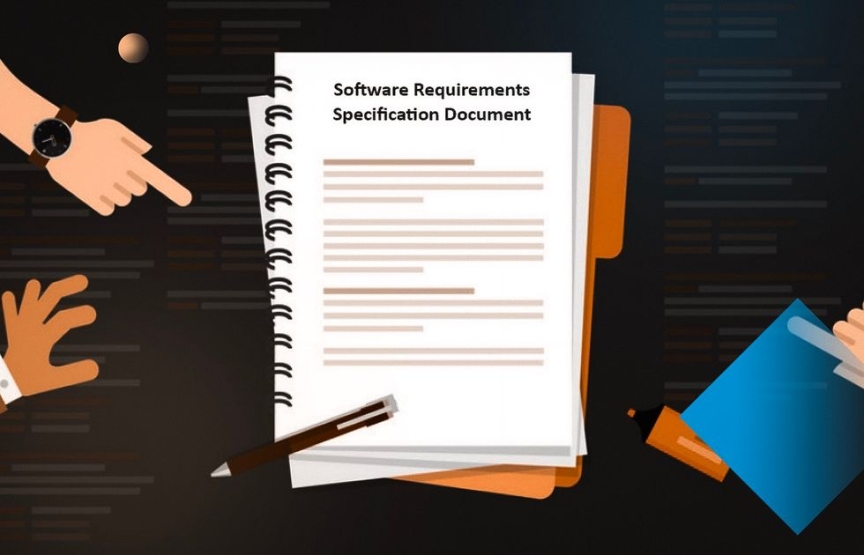How to Write a Software Requirements Specification Document (Templates Included)

A Software Requirements Specification (SRS) document is the backbone of any successful software project. It defines what the software will do and how it is expected to perform. For developers, it provides a clear roadmap. For clients, it offers confidence that their vision is understood. And for teams, it ensures everyone is on the same page.
In this guide, you’ll learn what an SRS document is, why it’s essential, what it includes, and how to write one effectively.
What is a Software Requirements Specification (SRS) Document?
An SRS document is a formal description of a software system’s functional and non-functional requirements. It acts as a bridge between stakeholders—such as clients, users, and developers—and outlines what the software must do without dictating how it will be done.
An SRS helps prevent misunderstandings, scope creep, and project delays by clearly defining expectations from the start.
Why is an SRS Document Important?
Here’s why writing an SRS document is crucial:
- Clarity and Agreement: Everyone understands the scope and goals of the project.
- Project Planning: Helps in estimating costs, time, and resources.
- Design Foundation: Provides a basis for software architecture and interface design.
- Development Roadmap: Developers know exactly what to build.
- Testing and Validation: Testers can build test cases based on specified requirements.
- Future Maintenance: Makes it easier to update or scale the software later.
What Does an SRS Document Include?
A well-structured SRS document typically includes the following sections:
1. Introduction
- Purpose: Why the document exists.
- Intended Audience: Who should read it.
- Scope: What the software will and won’t do.
- Definitions and Acronyms: Clarify technical terms and abbreviations.
2. Overall Description
- Product Perspective: Where the system fits in.
- User Needs: High-level user expectations.
- Assumptions and Dependencies: Any external factors or limitations.
3. Functional Requirements
- Specific features the software must include.
- Example: “The system shall allow users to log in using a valid username and password.”
4. Non-Functional Requirements
- Performance, scalability, usability, reliability, and security standards.
- Example: “The application shall respond within 2 seconds for 95% of requests.”
5. External Interface Requirements
-
How the software will interact with:
- Users (UI)
- Hardware
- Other software or APIs
- Communication protocols
6. System Models (Optional)
-
Use case diagrams, flowcharts, data models.
7. Appendices
-
Additional information like references, legal notices, or data formats.
How to Write an Effective SRS Document
Creating a well-structured and accurate Software Requirements Specification (SRS) document is crucial to the success of any software project. It ensures that all stakeholders have a shared understanding of what the software will do, and it provides a solid foundation for design, development, and testing.
Below are the key steps to writing a practical and professional SRS document, with detailed guidance at each stage:
Step 1: Gather Requirements Thoroughly
Start by collecting detailed requirements from all relevant stakeholders, including clients, users, developers, testers, and project sponsors. This step is about understanding the true needs behind the project.
-
Use multiple techniques such as:
- Stakeholder interviews
- Focus group discussions
- Questionnaires or surveys
- Observation of user workflows
- Requirement workshops (e.g., Joint Application Development sessions)
-
Ensure you cover:
- Functional needs (what the system must do)
- Business goals (why the system is being developed)
- Constraints (budget, deadlines, technology stack)
✔ Tip: Document assumptions, edge cases, and unresolved issues to revisit later.
Step 2: Define the Scope Clearly
Clearly defining the scope of the software system helps prevent misunderstandings and scope creep—the gradual expansion of project requirements beyond the original goals.
-
Include:
- A concise overview of what the system will and won’t do.
- A list of in-scope and out-of-scope features or modules.
- The boundaries of the system and its interaction with external systems.
✔ Tip: Use diagrams such as context diagrams or high-level system overviews to visually represent the scope.
Step 3: Use Clear, Measurable, and Unambiguous Language
Ambiguity is one of the biggest threats to an SRS document. Every requirement should be written in a way that cannot be misinterpreted.
-
Avoid vague terms like:
- “Fast” → Instead: “Response time shall not exceed 2 seconds for 95% of user requests.”
- “User-friendly” → Instead: “The system shall provide tooltips for all input fields.”
-
Use:
- Standardized terminology
- Unique IDs for each requirement (e.g., FR-001, NFR-005)
- Active voice and consistent sentence structure
✔ Tip: If possible, use structured requirement templates (e.g., “The system shall...”) to maintain uniformity.
Step 4: Prioritize Requirements
Not all requirements have equal weight. Prioritizing helps manage time, budget, and expectations effectively—especially in Agile or incremental development settings.
-
Common prioritization categories include:
- Must-Have – Essential for system operation or compliance
- Should-Have – Important but not critical; can be deferred
- Nice-to-Have – Useful enhancements or optional features
- Future – Planned for later versions or updates
✔ Tip: Use prioritization tools like MoSCoW Method or Kano Model for stakeholder buy-in.
Step 5: Review, Validate, and Get Sign-Off
Before finalizing the SRS, it’s vital to review and validate the document with all stakeholders.
-
Perform:
- Internal reviews with the development and QA teams
- Stakeholder validation sessions to confirm that requirements reflect expectations
- Walkthroughs or peer reviews to catch inconsistencies or technical gaps
-
Ensure:
- All sections are complete
- Requirements are feasible, testable, and traceable
- Stakeholders sign off or formally approve the document
✔ Tip: Maintain a requirements traceability matrix (RTM) to map requirements to design and test cases.
Step 6: Implement Version Control and Change Management
As the project progresses, new requirements may arise, and existing ones may evolve. Having a version control system ensures changes are documented and traceable.
-
Include:
- A revision history table at the beginning of the document
- Clear documentation of changes (who made them, when, and why)
- A change approval process to control updates
✔ Tip: Use versioning tools (like Git for documents, or project management systems like Jira or Confluence) to track changes effectively.
By following these steps, you can create an effective SRS document that serves as a reliable foundation for your software project—minimizing risks, improving communication, and ensuring the final product meets stakeholder expectations.
SRS Document Template (Outline Format)
Here is a structured SRS document template you can use as a foundation for any software project:
1. Introduction
1.1 Purpose
1.2 Intended Audience
1.3 Scope of the System
1.4 Definitions, Acronyms, and Abbreviations
1.5 References
1.6 Overview of the Document2. Overall Description
2.1 Product Perspective
2.2 Product Functions (High-level list of what the system will do)
2.3 User Classes and Characteristics
2.4 Operating Environment
2.5 Design and Implementation Constraints
2.6 Assumptions and Dependencies3. Functional Requirements
For each function, define:
- Requirement ID (e.g., FR-001)
- Description
- Inputs
- Outputs
- Behavior and rules
- Acceptance criteria
4. Non-Functional Requirements
4.1 Performance
4.2 Security
4.3 Reliability
4.4 Maintainability
4.5 Scalability
4.6 Usability5. External Interface Requirements
5.1 User Interfaces (screens, navigation, UI requirements)
5.2 Hardware Interfaces (devices, sensors, etc.)
5.3 Software Interfaces (APIs, other systems)
5.4 Communication Interfaces (protocols, messaging, data format)6. Use Case Scenarios (Optional but Recommended)
6.1 Use Case Diagrams
6.2 User Flows or Sequence Diagrams
6.3 Process Flowcharts7. Appendices
- Glossary of Terms
- Legal or Regulatory Info
- Additional Notes
8. Revision History
- Version: 1.0
- Date: YYYY-MM-DD
- Author: Name
- Description of Change: Initial Draft
9. Approval Section
- Sign-off section for stakeholders and development teams.
Best Practices for Writing SRS Documents
- Keep it user-focused but developer-friendly.
- Break complex requirements into smaller, actionable parts.
- Include diagrams where necessary.
- Regularly update the SRS throughout the project lifecycle.
- Use templates to maintain consistency across projects.
Real-World Example of an SRS Document
Let’s look at a simplified example for a Library Management System.
Example: Functional Requirement
FR-001: Book Search Functionality
The system shall allow users to search for books by title, author, or ISBN using a search bar on the homepage. Results shall be displayed within 2 seconds and sorted by relevance.
Example: Non-Functional Requirement
NFR-003: System Availability
The system shall be available 99.9% of the time during library operating hours (8:00 AM to 8:00 PM, Monday to Saturday).
Example: Scope
The Library Management System will include modules for user registration, book lending, search, and reporting. It will exclude integration with external libraries or publishers in this version.
Example: External Interface Requirement
EIR-002: Barcode Scanner Integration
The system shall support input from USB barcode scanners to identify books during the lending and return processes.
This example illustrates the clear structure, ID tagging, measurable expectations, and division between requirement types—all of which are essential in real-world SRS documents.
Frequently Asked Questions (FAQs)
Is an SRS document necessary for small projects?
Yes, even small projects benefit from clarity and direction. A lightweight SRS can save time and prevent rework.
Who prepares the SRS document?
Usually a Business Analyst, Project Manager, or Software Engineer, often with input from stakeholders.
Is an SRS the same as a design document?
No. An SRS defines what the software should do. A design document explains how it will do it.
Can SRS change after development starts?
Yes. It can evolve with formal change requests and proper version control.
Download Software Requirements Specification Document Templates
Ready to start your own software-development venture?
The following software requirement specifications template examples outline all key components of a great SRS document, giving you and your team valuable insight into the product you will develop.
Remember to keep your requirements detailed, clear, and concise, so all parties have the same vision in mind.
Trending ↝
➤ How To Check If Company / Business Name Is Registered in Nigeria With CAC
➤ Pastor Jerry Eze Whatsapp Channel – Official Link, How to Join & What to Expect
➤ NECO Timetable 2025 (PDF Download) – Full SSCE Internal Exam Schedule
➤ List of 36 States Governors in Nigeria, Their Deputies, and Political Parties (2025)
➤ NSPPD Live Today: Prayer Time, How to Join, Testimonies, Declarations, & Giving Information
➤ How To Contact GOtv Customer Care in Nigeria
➤ How To Check Vehicle Number Plate Registration in Nigeria
➤ NELFUND Student Loan: Portal, Login, How to Apply, All You Need to Know
➤ Local Government Areas (LGAs) in Lagos State: Full List & Details
➤ How To Write An Informal Letter
➤ How to Check NIN Number Online Using Phone USSD Code *346#
➤ List of All Davido’s Songs and Albums – Every Track from 2011 to 2025





